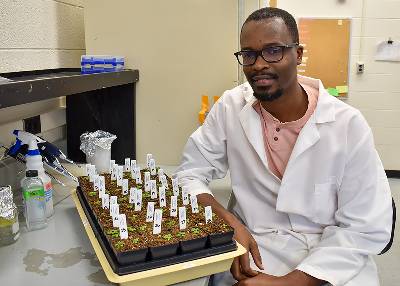Benning lab receives NSF grant to bring research into undergraduate classes
Researchers in the Benning lab within the Michigan State University-Department of Energy (DOE) Plant Research Laboratory (PRL) have received a $1.1 million grant from the National Science Foundation (NSF) to bring research into the undergraduate classroom setting. The project looks at how the chloroplast reacts to stress responses in the model plant Arabidopsis thaliana.

Jinjie Liu, assistant professor in the MSU College of Natural Science’s Biological Sciences Program and grant co-PI, along with Christoph Benning, principal investigator and PRL director, developed a research project that could be worked on in both the lab and classroom. This Course-based Undergraduate Research Experience (CURE), which Liu teaches, was created as a Cell and Molecular Biology laboratory course in the fall of 2018.
“We are connecting the research lab environment with the classroom environment,” said Benning, who oversees the lab portion of the project. “This is part of the missions of both MSU and NSF: Train students in basic sciences and give them a good experience in the lab.”
Students in Liu’s undergraduate laboratory class sow the Arabidopsis seeds, let the plants grow and isolate the ones with the specific characteristics the researchers are looking for. In the process, they learn important research techniques that are commonly used.

Jinlie Liu, assistant professor, Biological Sciences Program. Credit: Kara Headley, MSU-DOE Plant Research Laboratory
“The goal for this course is for students to not only learn techniques and concepts used in the lab, but to learn why we do what we do,” Liu said.
Benning lab researchers are looking for suppressor mutants in engineered plants that release fatty acids from chloroplast membranes which initiates lipid-based signaling causing reduced growth. The long-term goal is to explore how two plant stress hormones, abscisic acid (ABA) and jasmonic acid (JA), interact in their response to environmental stressors.
“By understanding more of how the signaling that happens between the ABA and JA pathways, we hope to find novel gene(s) and factors involved in the signaling process that can be later used to engineer crops that are more resilient to the environmental insults,” Liu said.

“This project will generate knowledge that will inspire novel strategies to produce crop plants that easily adapt to changing climate and feed a growing population,” added Yosia Mugume, the postdoctoral researcher in the Benning lab working on this project.
This research builds on previous projects from the PRL, including a paper from the Benning and Howe labs, published in The Plant Cell, that described two chloroplast lipases, PLIP2 and PLIP3. One of the first mutants discovered during this project by graduate student Ron Cook, has a mutation in a protein known as “Keep on Going” (KEG), which acts at the interface of ABA and JA signaling.
“Keep on Going is also the English translation of my last name, Mugume, from my tribal language Rukiga from Western Uganda,” Mugume said.
Banner image: The Benning lab’s NSF-funded project connects the research lab environment
with the classroom environment by developing a classroom project that looks at how
the chloroplast reacts to stress responses in the model plant Arabidopsis thaliana.Credit:
Kara Headley, MSU-DOE Plant Research Laboratory